Pentax Optio A30 Review
Pentax Optio A30
Is this the camera that can put Pentax back at the top?
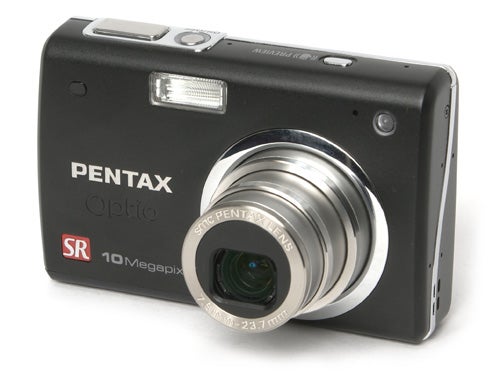
Verdict
Key Specifications
- Review Price: £160.00
I’ve always liked Pentax cameras. I’ve owned several Pentax 35mm and Digital SLRs over the past twenty-five years and I’ve taken some of my favourite photos with them. However I try not to let my personal bias get in the way of an objective review, and it has to be said that over the past couple of years I have not been particularly impressed by many of Pentax’s Optio range of digital compact cameras.

About four years ago the Optio range represented the state of the art. Models such as the Optio 555 and Optio S were outstanding compact and ultra-compact cameras with innovative optical technology, good picture quality and unbeatable value for money. However the market moved on, other manufacturers overtook Pentax’s lead in optical design, producing slimmer, faster cameras with better picture quality, and the Optio range slowly slipped downmarket. Recent models such as the T20 and E30 have been frankly disappointing, especially so because I know that Pentax is capable of so much more. What it has been lacking is a new breakthrough model, something to put it back on top, and give the Optio range a much-needed shot in the arm. I believe that with the launch of the Optio A30 Pentax may just have found what it needs.
The specification is ambitious to say the least. The A30 is a 10-megapixel ultra-compact with a larger-than-usual 1/1.8-inch CCD sensor, flush-folding 3x zoom f2.8-5.4 lens (38mm-114mm equiv.), 3200 ISO maximum sensitivity, 2.5-in 232K pixel LCD monitor, DivX movie recording, face detection, manual exposure options and no less than three types of shake reduction, all in a camera measuring 57.5 x 89.5 x 23.5mm and weighing just 130g. That wish-list of features puts it straight into the top bracket of digital compacts alongside the best of Canon’s Digital IXUS range and Sony’s N-series cameras.
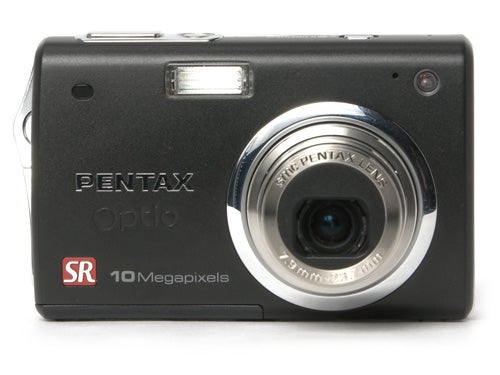
It certainly has a price to match. The A30 is officially listed at £249.99, although despite only being launched in February this year there are already a number of online retailers offering it for under £160. There aren’t many comparable models at this end of the market, but the closest matches are the Canon IXUS 900 Ti (£230)and the Sony Cyber-shot DSC-N2 (£230), so in terms of price the Pentax is definitely competitive. The only cheaper 10MP ultra-compact is the Casio Exilim EX-Z1050 (£145) but it doesn’t have as many features as the A30.
Upon opening the box, the immediate impression is of a nice looking camera. It is stylish without being too flashy, with a strong all-metal case finished in matt black with chrome trim. Build quality is excellent, with a good close fit between the body panels and controls. The card/battery hatch on the underside is plastic, but it has a spring-loaded metal hinge and a good secure latching action. The tripod bush is plastic, but it is quite a hard plastic and is centrally mounted for optimum support. The A30 is equipped with Pentax’s Sliding Lens System, so the lens retracts completely flush with the body, giving the camera a very pocket-friendly profile.
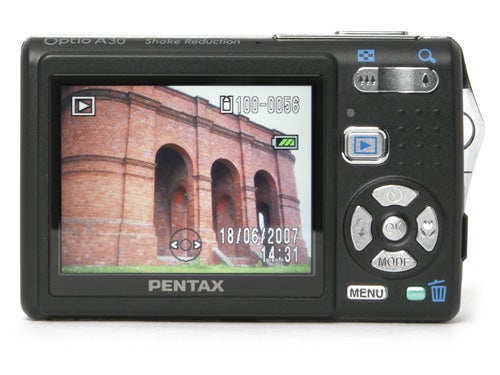
The control layout is nice and simple, with just three buttons, the D-pad and the zoom control on the back panel, leaving a small textured area for your thumb. Despite the small size, smooth shape and the lack of any sort of finger grip the A30 is surprisingly secure to hold. The controls include Pentax’s popular Green Button feature, which has a default setting of full idiot-mode auto, but this can be changed in the menu for a number of useful functions. All the main shooting modes are found, logically enough, on the Mode button, the down button of the D-pad. These include a shorter than usual list of just 10 scene modes, including all the usual favourites (landscape, portrait, night portrait, sport, snow & beach etc.) however several of them have sub-divisions when selected. For example the Portrait mode has a sub-setting for kids, while the Pets mode has sub-settings for light, mid-tone and dark coloured animals. It also has sub-settings for cats and dogs, although a Pentax spokesman did confirm that actually these are identical, just with different icons. Naturally the Mode selection also includes the wonderfully dreadful Frame Composite mode, but then I’d be kind of disappointed if it didn’t.
One unusual mode for a pocket compact is found as a sub-setting of program mode. The A30 has shutter priority and full manual exposure settings, which will be welcomed as creative tools by more experienced photographers. Only minimum or maximum apertures can be selected, but the full range of shutter speeds, 4 secs to 1/2000th, are available.
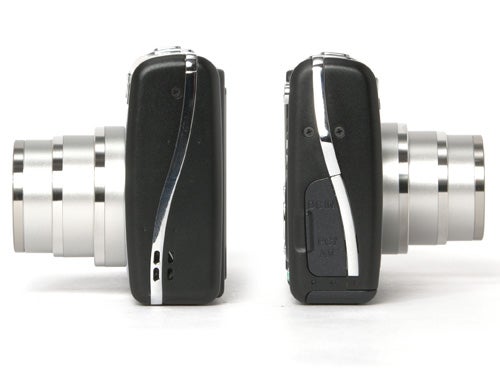
The A30 is equipped with the same CCD-shift image stabilisation system that Pentax uses in its K100D and K10D digital SLRs, with the same results. It’s a very good system, and reliably produces up to three stops of extra low-speed stability. I found I was able to take shake-free hand-held shots at the maximum telephoto setting (114mm equiv.) at shutter speeds as low as 1/10th of a second, which is a pretty impressive performance. The marketing blurb promises “Three types of shake reduction”, but like most marketing that’s a bit ambiguous. What it has, apart from the excellent CCD-shift system, is a “Digital SR” mode which merely sets a high ISO sensitivity to produce faster shutter speeds, which is usually best avoided since it produces more image noise.
The third shake reduction system is an electronic image stabilisation system for the video mode. This does in fact work very well, producing good shake-free video clips comparable with a mid-range camcorder. It shoots at the standard resolution of 640 x 480 and 30 frames a second. Unfortunately the zoom lens cannot be used when filming (digital zoom only, up to 5.4x), but the DivX compression system does mean that a 1GB SD card is enough for 47minutes of filming.
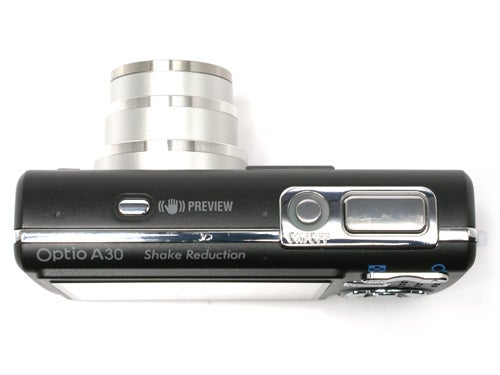
Overall performance has been one area where I have had a lot of criticism of recent Optio compacts. They have been getting better, but still lag behind the best of the competition. The A30 is the best yet by a significant margin, and is certainly not the slowest camera around, but it’s not the quickest either. It starts up in just over 2.5 seconds, but shuts down again in under two. In single-shot mode it has a shot-to-shot time of just less than three seconds, but in continuous mode it is somewhat faster, managing a frame every 0.8 seconds which it can maintain until the memory card is full. At the maximum quality setting a 1GB SD card provides enough space for approximately 304 shots, with JPEG files of around 3MB, which is about average for a 10MP camera. There was a wider than usual variation in JPEG file sizes, ranging from under 2MB to over 4MB, but I didn’t find compression artefacting to be a major problem even on the smaller files.
Focusing speed was also much improved over previous models, and now compares favourably with most of the competition. Only Canon and Casio are noticeable faster. It does slow down a little in reduced light, but the AF assist lamp means it can focus in darkness at a range of several metres. Flash output and coverage was also exceptionally good, with a range of 7.1m at wide angle and 3.5m at telephoto. It was also very good at close range, producing perfectly even illumination at just a few inches.
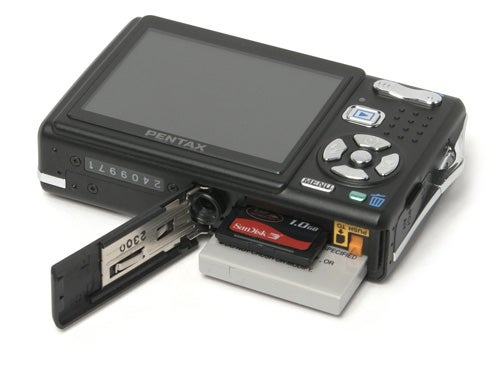
Image quality is one of the A30’s many strong points. At low ISO settings (64-200) the level of fine detail, the edge sharpness and the richness of the colour rendition were among the best I’ve seen from a compact camera. At higher ISO settings noise did become more of a problem, but the A30 uses an unusual noise reduction algorithm which is very good at retaining edge sharpness and contrast detail even when noise levels are quite high, avoiding many of the problems associated with previous 10MP compacts. Even at 800 ISO noise was only prevalent in darker areas, with colour rendition and sharpness still retained, both of which are important for print quality. The lens too performed well, producing some barrel distortion at wide angle but with good corner and edge sharpness at all focal lengths.
”’Verdict”’
The Optio A30 is Pentax’s best ultra-compact camera to date, combining stylish design, excellent build quality, easy handling and much improved performance, with outstanding picture quality and a comprehensive set of features including many unusual and useful options. It is a superb camera and one which puts Pentax firmly back into contention at the top of the market.
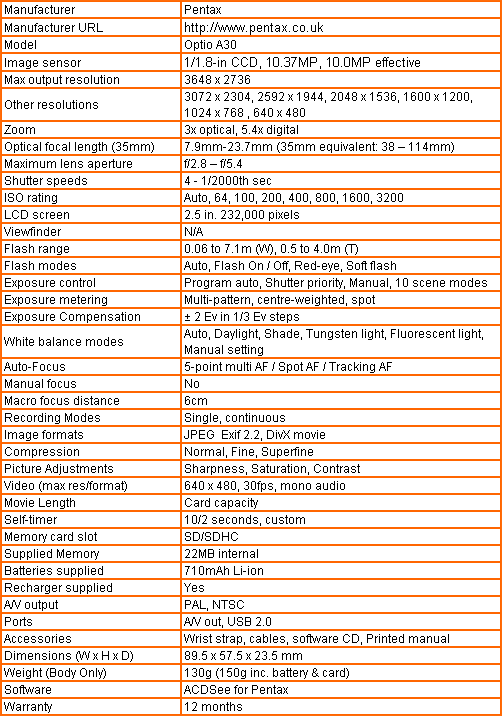
”A range of test shots are shown over the next few pages. Here, the full size image at the minimum ISO setting has been reduced for bandwidth purposes to let you see the full image, and a series of crops taken from original full resolution images at a range of ISO settings have been placed below it in order for you to gain an appreciation of the overall quality.”
—-

—-

At the minimum ISO 64, picture quality is outstanding, with rich colours, tons of pin-sharp detail and no noise at all.
—-

Likewise at 100 ISO picture quality is superb.
—-

At 200 ISO there is a hint of chromatic noise in the darker areas, but detail and contrast are unaffected.
—-

There is more colour speckling in this 400 ISO shot, but the lettering in the motto banner below the crest is still plainly readable.
—-

Noise is starting to become a problem at 800 ISO, but the sharp edge detail and colour accuracy would still make a usable print.
—-

At 1600 ISO, the highest manually selectable setting, image noise is now quite bad across the whole image, and fine detail has been completely lost.
—-
”A range of test shots are shown over the next two pages. Here, the full size image has been reduced for bandwidth purposes, and in some case a crop taken from the original full resolution image has been placed below it in order for you to gain an appreciation of the overall quality.”
—-

Here’s usual detail test shot. See below for a full res crop, or click to see the whole picture.
—-

The level of detail produced by the lens 1/1.8-in sensor is exceptionally high, among the best of 10MP compacts.
—-
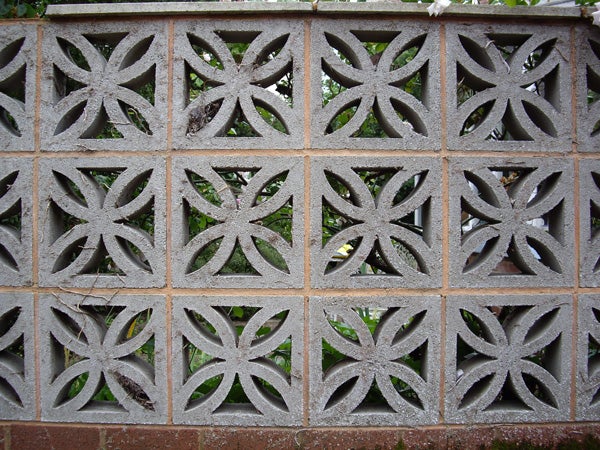
The lens does produce noticeable barrel distortion at the wide-angle end of the zoom range, but overall sharpness and detail are excellent.
—-

This corner crop from the above image shows the high level of edge and corner sharpness. It only falls off in the extreme corner of the frame.
—-

Unlike a lot of 10MP sensors the A30 copes well with high contrast.
—-

There is almost no fringing around this high contrast edge.
—-

The wide-angle end of the zoom range is equivalent to 38mm.
—-

Taken from the same spot at the telephoto end, equivalent to 114mm
—-
”A range of test shots are shown over the next two pages. Here, the full size image has been reduced for bandwidth purposes, and in some case a crop taken from the original full resolution image has been placed below it in order for you to gain an appreciation of the overall quality.”
—-

Colour rendition is perfect despite the cloudy weather.
—-
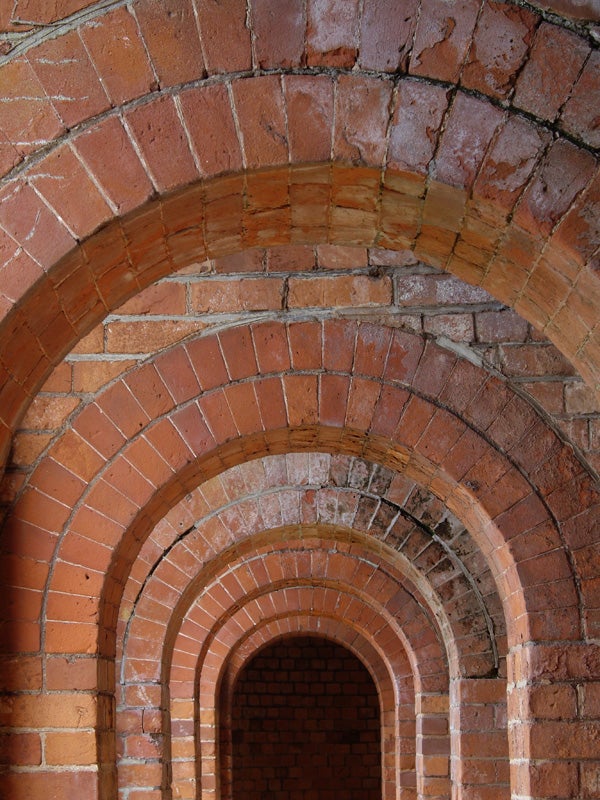
Exposure metering is also spot on. Spot. Metering. Geddit?
—-

Flash range is an impressive 7.1 metres at wide angle, and frame coverage is superb.
—-

If you thought I was kidding about the frame composite mode, hopefully these beautiful flowers will convince you otherwise.
—-
Trusted Score
Score in detail
-
Value 7
-
Image Quality 9
Features
| Camera type | Ultra Compact |
| Megapixels (Megapixel) | 10 Megapixel |
| Optical Zoom (Times) | 3x |
| Image Sensor | CCD |
| Image Stabilisation | Optical |
| LCD Monitor | 2.5 in |
| Flash modes | Auto Flash, Red-eye Reduction, Flash ON, Flash OFF |
| Video (max res/format) | 640 x 480 |
| Memory card slot | Secure Digital (SD) Card |

